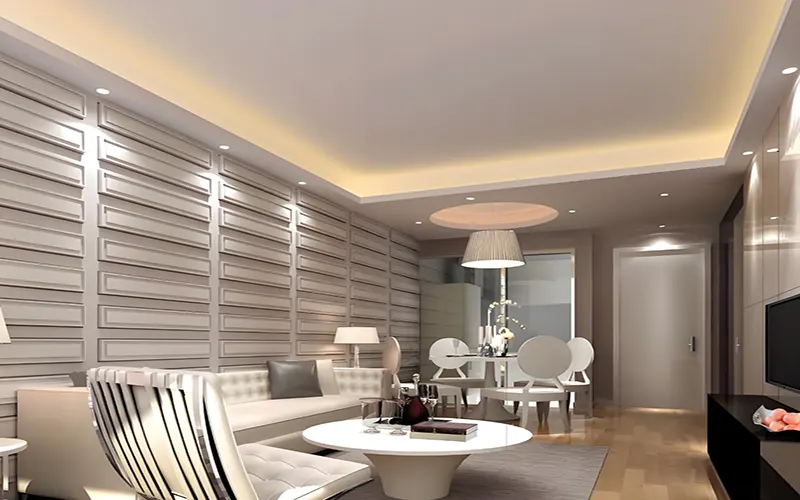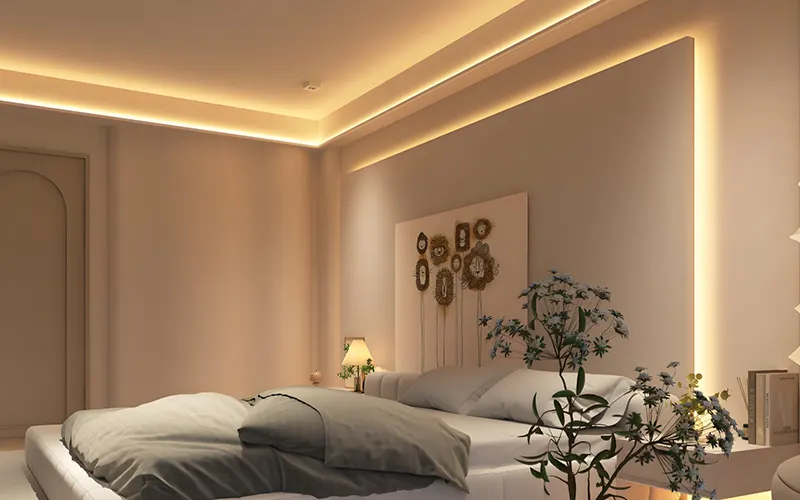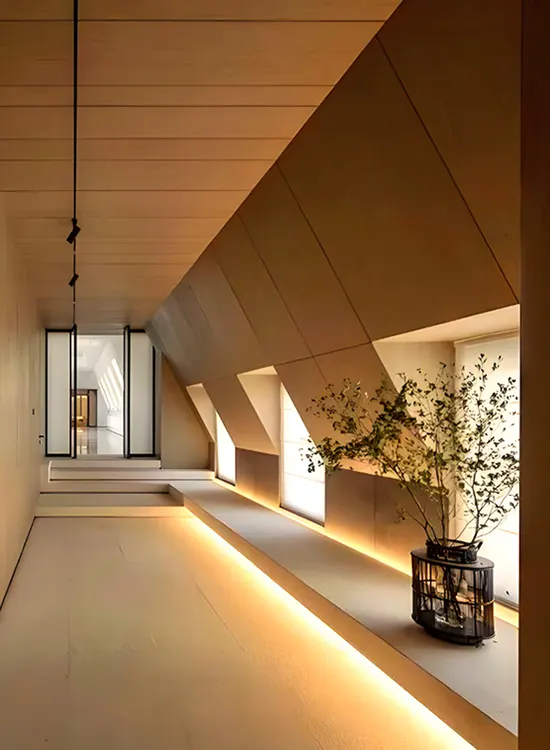When you are buying LED strips, you’ll find a wide variety of them on the market, with complex specifications. Why do prices vary so dramatically for the same strip? With so many specifications, what details should you understand first? How can you avoid buying a product that’s unsuitable for your project? How can you choose the best LED light strip for your needs from a wide range of options?
This article will analyze eight key considerations when purchasing LED strips, based on your actual application, to help you easily are buying high-quality, long-life, and stable LED strips. More details, pls read Everything You Need to Know Before Buying LED Neon Flex
1: Indoor or outdoor? Decoration or illumination?
Before purchasing an LED light strip, you need a plan. First, clarify a key question: what is your intended use case? What is your purpose for purchasing it?
Buying LED strips for indoor use
LED strips for indoor use are generally used for two purposes: primarily for decorative ambiance and as auxiliary lighting.
- Living room ceiling: Install warm white or neutral white light strips to create a soft, layered feel.
- Under-cabinet lighting: For kitchens, wardrobes, or bookshelves, choose light strips with a high color rendering index (CRI) to enhance the natural appearance of objects.
- TV background wall: RGB or RGBIC light strips enhance visual impact and reduce eye strain.
Outdoor or Wet Environments
If you plan to install LED light strips outdoors or in humid areas, such as gardens, balconies, or poolside, waterproofing is essential. I recommend at least IP67 waterproofing.
If they need to be submerged in water for short or long periods, such as in swimming pools or fountains, then IP68 neon tubes are a must.
Decorative vs. Primary Lighting
LED strips are generally used for decorative and ambient lighting. You can choose based on your needs.
Decorative uses, such as ceiling troughs, bar counters, or wall backdrops, primarily focus on creating a visually appealing atmosphere.
Lighting uses, such as kitchen countertops, cabinet lighting, and linear ceiling lights, require higher brightness and color rendering index.
2: Understanding Lamp Bead Brands and Types
When choosing an LED light strip, the type of lamp bead and chip brand are crucial factors. They are key factors affecting light efficiency, lifespan, and color stability.

Different lamp bead types determine a strip’s brightness, power consumption, light uniformity, and intended use. If you want to choose a light strip that’s both efficient and durable, you should first understand these common lamp bead types and their performance differences.
Common Lamp Bead Models
- 3528 LEDs: These are smaller in size and lower in brightness, primarily used for decorative or ambient lighting. High-density 240 LEDs are particularly popular, offering low power consumption and a high cost-effectiveness.
- 2835 LEDs: Currently the most popular choice, offering high brightness, excellent energy efficiency, and superior heat dissipation. They are commonly used in areas requiring high illumination, such as kitchens, cabinets, and ceiling troughs.
- 5050 LEDs: Larger in size, they primarily offer RGB or RGBW multi-color switching, making them suitable for venues requiring dynamic lighting effects, such as stage lighting, KTVs, and party decorations.
- 2216 / 2110 / 3014 / COB LEDs: These utilize the next-generation high-density packaging technology. This is particularly true for COB LED strips. They offer continuous, soft, and grain-free light, making them ideal for high-end residential, display cabinet, or commercial lighting projects, creating a professional and comfortable lighting environment.
Chip Brand Quality
The chip is the “core brain” of LED bulbs, directly affecting their lumen decay, color rendering index (CRI), and lifespan. It’s recommended to choose chips from reputable brands, such as:
- San’an: A renowned Chinese chip manufacturer, offering excellent value for money and widely used in home and commercial lighting.
- Epistar: A Taiwanese brand renowned for its stable brightness and consistency.
- Nichia: A high-end Japanese brand known for high color rendering, high efficiency, and low lumen decay, suitable for projects demanding high-quality lighting.
- Cree: An American brand, offering excellent brightness and durability, it’s a top choice for high-end industrial lighting.
3: Brightness and Power Selection
Brightness and power go hand in hand. Both determine the lighting effect of a light strip, typically measured in lumens (lm). When purchasing, consider the following indicators:
- Key Parameters: Luminous flux: This measures the total amount of light perceived by the human eye, measured in lumens. The higher the lumen value, the brighter the strip.
- Luminous efficiency is a key indicator: It measures the number of lumens produced per watt of electrical energy. Higher luminous efficiency means less energy consumption at the same brightness. High-quality strips typically have higher luminous efficiency.
- LED density: The more LEDs per meter, the more uniform the brightness across the entire strip.
4: Appropriate Color Temperature and Color Rendering Index
LED light strips typically have a color temperature of 2700K-6000K, though other color temperatures are also customizable.
- Warm white light in the 2700-3000K range exhibits a warm, yellowish hue and is suitable for spaces requiring a cozy and comfortable atmosphere, such as bedrooms and dining rooms.
- Natural white light in the 4000-4500K range is closest to natural midday sunlight, offering natural color reproduction and suitable for areas requiring clarity and brightness, such as kitchens and offices.
- Cool white light in the 5500-6500K range exhibits a refreshing white with a slight bluish tint and is primarily used in spaces requiring a professional, bright appearance, such as commercial displays and medical spaces.
The Color Rendering Index (CRI) measures a light source’s ability to reproduce the true colors of an object. Currently, we recommend choosing high-color rendering light strips with a CRI of 90 or higher to ensure accurate color reproduction. Some professional light strips can even reach CRIs above 95, approaching the color rendering of natural light.
5: Check the IP Rating
Whether used indoors or outdoors, if exposed to water or moisture, you should consider the IP rating of your LED light strip.

- IP20: Not waterproof, suitable for use only in completely dry indoor environments.
- IP65: Dustproof and water-resistant, suitable for use in kitchens, bathrooms, and outdoors (not exposed to direct rain).
- IP67: Suitable for outdoor use and can withstand rain.
- IP68: Safe from continuous immersion, ideal for underwater applications (such as swimming pools and water features). We have a IP68 neon strip can used for underwater.
6: What length of LED light strip should I connect to the power supply?
Generally, our LED light strips are sold in 5-meter rolls, but you can cut them to fit the space you need for your installation. Custom sizes are also available if needed. The following installation length guidelines are provided as a guide. More information, pls check How to Choose a Power Supply for LED Strips
- For short-distance applications (<5 meters), the original power supply can be used directly.
- For medium- to long-distance applications (5–15 meters), it is recommended to use 24V light strips, and the power supply should be connected at both ends of the LED strip to reduce voltage loss.
- For long-distance projects (>15 meters), a segmented power supply or amplifier is required to ensure consistent brightness.
7: Voltage selection: 12V, 24V, or high-voltage LED strips?
The voltage you choose affects installation complexity and performance, and it primarily depends on the type of project you’re working on.

- 12V/24V low-voltage light strips: Safe, without the risk of electric shock, but require a switching power supply. However, they can suffer from voltage drop, meaning the ends of the strips can dim if they’re too long. 24V light strips have less voltage drop than 12V, making them a better choice for longer installations.
- High-voltage light strips: Low voltage drop allows for longer runs. However, installation requires more caution, as they involve high voltage, so it’s recommended that a professional electrician perform the installation.
8: Adjusting the color and brightness of LED lights
All of our LED light strips are dimmable; all you need is a dimmer. If you need to change the color, you’ll need to choose a light strip with a variable color temperature.
- Monochromatic dimming: A power supply that supports PWM dimming or an additional dimmer is required.
- RGB/RGBW color change: A corresponding controller is required to achieve switching between tens of millions of colors and dynamic mode changes.
Choosing a Reliable LED Strip Supplier
When buying LED light strips, consider not only the product specifications but also the supplier’s expertise and service assurance. We offer high-quality LED strips, along with reliable delivery capabilities and a robust technical support team.
If you still have questions, please visit the NEON LED STRIP official website for personalized purchasing advice! If you need more, pls check How to Choose the Perfect Flexible LED Strip Lights?
FAQs
For home use, you can consider the following based on your needs. The most critical parameters are brightness (lumens/meter), color temperature (Kelvin), and color rendering index (CRI). These factors determine lighting comfort and true color rendering. Generally, we recommend choosing products with a brightness of 800–1200 lm/m, a color temperature of 2700K–4000K, and a CRI ≥90.
First, we need to check the strip’s luminous efficacy (lm/W). A higher efficacy indicates more light per unit of power, meaning it’s more energy-efficient. High-quality LED light strips typically have luminous efficacy exceeding 100 lm/W and are also labeled as CE, RoHS, and other certifications.
This is because different strips have different luminous efficacy and chip quality. Of course, different sizes of LEDs will also produce different luminous flux at the same wattage. There’s also a significant difference between high-quality and low-quality LEDs.
Yes, because you’re using low-voltage LED strips, 12V and 24V. Therefore, you typically don’t get your own power adapter. You’ll need to choose a power supply that matches the total wattage and voltage of the strip.
Contact us. We offer a full range of light strips, from COB to RGB, and can customize length, brightness, and control methods to meet your project needs.
